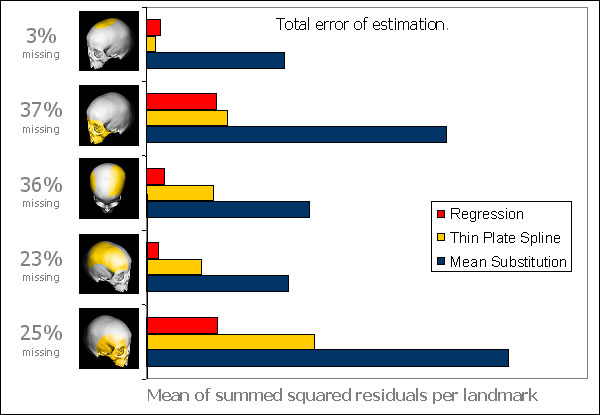Since rich digital data is available in Virtual Anthropology, the process of reconstruction can be enhanced in ways to which physical reconstruction has no access. Geometrical or statistical information can be integrated from an individual reference specimens or even whole reference populations.
Although the traditionally operating researcher has a reference in his mind as well when he sets out to reconstruct a particular specimen, the formalized approach in Virtual Anthropology forces one to uncover the underlying presumptions, which in turn leads to a more transparent and reproducible way of doing science. Reference based reconstructions also go far beyond the possibilities of simple mirror imaging or assembling of fragments of one or more specimens:
Geometric reconstruction
It is possible to predict missing parts based on geometric properties of a single specimen, such as smoothness of curvature. For this purpose the thin plate spline interpolation function is used: Missing data is estimated by mapping a complete case to the specimen with missing landmarks - using the thin plate spline interpolation based on the subset of observable landmarks. This reference specimen can be the Procrustes average of all complete cases or a single specimen that matches the specimen with missing data in some other variables such as age, size, sex or species.
If the dataset includes semilandmarks, it makes sense to combine the step of missing data estimation with a thin plate spline relaxation of the available semilandmarks against the reference specimen. While available semilandmarks slide on their tangents and tangent planes, missing landmarks are "fully relaxed" so as to minimize the bending energy between the reference and the target specimen. The whole idea of sliding landmarks is at root a missing data algorithm. In the case of curve-semilandmarks, one estimates the missing coordinate along a tangent vector; sliding on a surface estimates two coordinates. With "full relaxation" all three dimensions are estimated. To allow "full relaxation" all these missing coordinates are allowed to slide at the same time.
Statistical reconstruction

Another approach, statistical reconstruction, regards any landmark location as correlated with all other locations in the landmark set. Using the complete cases, one can use multiple multivariate regression to estimate the location of the missing points. This process requires of course the existence of a reference sample rather than the single reference specimen underlying the thin plate spline interpolation described above. Using the complete specimens, one predicts the location of the missing landmarks with the minimum sum-of-squares given the other data.